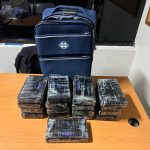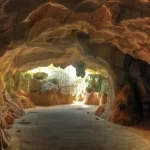Haitian gangs use Dominican Republic for money transfers

Although Haitian gangs do not exercise violence on the Dominican side of the border, many use the Dominican Republic as a depository for their money, a base for planning their operations, and a safe zone for the leaders’ families.
This is stated in an investigation by U.S. professor Evan Ellis, published by the Center for Strategic Studies of the Peruvian Army. The report was published in Extenso by the digital newspaper Acento.
The study, carried out by Ellis after a visit to the country at the end of last month to expose crime and violence, also points out that as the situation in Haiti has worsened, there have also been some kidnappings and crimes related to these groups on this side of the island.
Security concerns
The professor points out that the Haiti crisis has become the country’s leading political and security concern.
“Those consulted see the situation in Haiti as posing a serious threat to the country through the effects of violence, refugees, and other dynamics,” the research notes.
According to the study, the lens through which many Dominicans view Haiti is tinged by a complex history on the island, which includes a brutal 22-year invasion from 1822 to 1844, in which Haitian occupiers tried to eliminate the Dominican language, cultural, and religious traditions, among others.
It argues that the impact of the Haitian crisis in the Dominican Republic intensified in September 2023, when Haitian groups seeking water for irrigation began to build a canal to divert it from the Masacre River.
The study indicates that although the start of this work had been the subject of some consultation between the Haitians and the Dominicans, the size Haiti intended to give it threatened to divert the Masacre River, which would affect agriculture and the sustainability of downstream waters and have serious environmental consequences for both nations.
Illicit drug flows
On the other hand, Evan Ellis assures that the Dominican Republic is caught in the destructive interplay between youth gangs and illicit flows of drugs, money, and weapons from countries in the region.
The Latin American Studies researcher at the U.S. Army War College’s Strategic Studies Institute added that growing drug production in Colombia and Venezuela increased the trafficking of cocaine and other illicit products to the Dominican Republic.
The study argues that these flows had a corrupting impact on the country and its law enforcement system, which has long had to contend with corruption and other institutional problems.
Struggle for control over trafficking.
Due to its geographic position, the investigation notes, the country has been the scene of struggles between powerful Colombian and Mexican drug trafficking groups, and, as in other parts of the region, the Sinaloa and Jalisco New Generation cartels have established strong positions.
It notes that drug sales points in the country have increased, contributing to the deterioration of Dominican communities, which were facing economic and other problems.
The research indicates that the Dominican Republic has a large and capable security apparatus compared to its neighboring Caribbean partners, including the National Police, the Army, the National Drug Directorate (DNCD), and other bodies.
It adds that the government’s response to security challenges is hampered by corruption and institutional weaknesses. However, it has worked with neighbors like the United States to remedy deficiencies.
Concerning corruption, the study explains that those interviewed agreed that the government of Luis Abinader has made great strides in cleaning up government organizations in the security sector. However, they believe there is still much work to be done.















Not only Haitians but gangsters and drug criminals from Venezuela,Peru, Colombia and other Latin countries. Although there are strong laws in the DR relating to money laundering it is impossible to tell if these are complied with all the time. With the major banks, they require evidence that deposits from overseas are from legal sources but there are a large number of banks on the DR with ownership by people who are not Dominicans.
Well, those “strong” laws aren’t strong enough to crackdown on money laundering when foreigners hiding dirty money into banks. Basically the Switzerland of Latin America when dealing with degenerates like that.
I am a bit suspicious of the funders of this study… US Army War College Strategic Studies Institute…
the leaders of the gangs are known haitians polititians that have their family and fortune in DR, we all know that, that is not new. we all know about the many pen houses owned by them in punta cana and SD. we know they send their children to dominincan private schools ect. Only the poor haitians believe that their Elite has anything to offer to haiti. They only extract from haiti and spend elsewhere. Funny to see poor haitians fill their chest with nationalistc pride over the canal issue when that is just another project of the local elite to keep extracting from haiti.
There is an historical fact that Dominican children should learn at school, is that the institution of slavery of black people was abolished by Haitian president Jean Pierre Boyer in 1822 on the the eastern side side of the island of Hispaniola that was called then Haiti espagnol’ which became the Dominican republic in 1844. At least this Haitian president who had invaded that eastern part of the island should get that historical credit